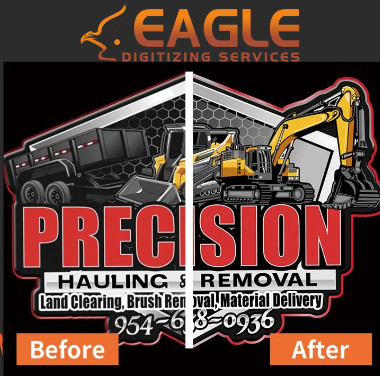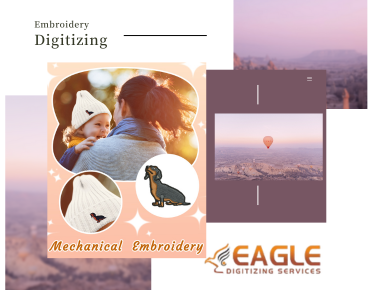How can you move objects within an embroidery design?
Embroidery digitizing, an ancient art form, has been revolutionized by modern technology. One of the key aspects of contemporary embroidery is the ability to manipulate design elements with precision and creativity. This article delves into the fascinating world of embroidery design manipulation, focusing on the importance of moving objects within a design to achieve aesthetic perfection and functionality.
Embroidery design manipulation involves
adjusting the position, size, orientation, and other attributes of various
elements within a design. This process allows for greater flexibility and
creativity, enabling embroiderers to create intricate and customized patterns.
The ability to move objects within a design is crucial for achieving balance,
symmetry, and overall visual appeal.
Importance of Moving Objects
in Embroidery
Moving objects within an embroidery
design is essential for several reasons. It ensures that each element is placed
correctly to enhance the overall composition. Precise placement can affect the
stitch quality and the final look of the embroidery. Moreover, the ability to
manipulate objects allows for corrections and adjustments, making it easier to
refine designs and achieve the desired outcome.
Understanding Embroidery
Software Tools
Introduction to
Embroidery Software
Embroidery software is the backbone of
modern embroidery design. These digital tools provide a platform for creating,
editing, and refining embroidery patterns. They offer various features and
functions that facilitate the manipulation of design elements with precision.
Overview of Design
Workspace
The design workspace in embroidery
software is a digital canvas where you can view and manipulate your embroidery
elements. It typically includes tools for drawing, editing, and arranging objects,
as well as a grid or guidelines for alignment.
Tools for Object
Manipulation
Embroidery software comes equipped with a
range of tools for object manipulation. These tools allow you to select, move,
rotate, scale, flip, and align objects, providing complete control over the
design process.
Basic Techniques for Moving
Objects
Selecting Objects in
Embroidery Software
The first step in manipulating any object
is selecting it. Most embroidery software offers multiple selection methods,
including clicking, lasso selection, and marquee selection, to isolate the
desired object or group of objects.
Moving Objects Using
Drag and Drop
The drag-and-drop method is the simplest
way to move objects. By clicking on an object and dragging it to a new
location, you can reposition it within the design. This method is intuitive and
effective for quick adjustments.
Using Arrow Keys for
Precise Movement
For more precise control, the arrow keys
can be used to nudge objects incrementally. This technique is particularly
useful for fine-tuning the placement of elements within a design.
Rotating Objects in Your
Design
Rotating Objects
Clockwise and Counterclockwise
Rotation is a powerful tool in embroidery
design. You can rotate objects clockwise or counterclockwise to achieve the
desired orientation. This can be done using rotation handles or specific
rotation tools within the software.
Adjusting Rotation
Angle
Most software allows you to specify the
rotation angle, offering greater precision. Adjusting the rotation angle can
significantly impact the design's aesthetics, adding dynamism and interest.
Effects of Rotation
on Design Aesthetics
Rotation can alter the visual flow of a
design, creating movement and direction. Careful consideration of rotation
angles can enhance the overall composition and draw attention to specific areas
of the design.
Scaling Objects for Proper
Placement
Importance of
Scaling Objects
Scaling is crucial for maintaining
proportionality and balance in a design. Proper scaling ensures that objects
fit well within the overall composition and do not overshadow or clash with
other elements.
Scaling
Proportionally vs. Non-Proportionally
Scaling proportionally maintains the
object's original aspect ratio, preventing distortion. Non-proportional scaling
allows for stretching or compressing an object, which can be useful for certain
creative effects but must be used judiciously.
Resizing Objects for
Design Balance
Resizing objects helps achieve visual
harmony. Balancing large and small elements can create a cohesive design,
enhancing both aesthetics and functionality.
Flipping and Mirroring
Objects
Flipping
Horizontally and Vertically
Flipping objects horizontally or
vertically can create mirror images, adding symmetry and balance to the design.
This technique is useful for creating repeating patterns or reflected elements.
Mirroring Designs for
Symmetrical Effects
Mirroring entire designs or specific
elements can produce symmetrical effects, which are often pleasing to the eye.
This method is commonly used in traditional embroidery patterns.
Practical
Applications in Embroidery
Flipping and mirroring are not just for
aesthetic purposes. They can also help in optimizing the use of fabric space
and ensuring that designs fit within specific dimensions.
Grouping and Ungrouping
Objects
Benefits of Grouping
Objects
Grouping objects allows you to manipulate
multiple elements as a single unit, simplifying complex designs and ensuring
consistency. This is particularly useful for moving or scaling intricate
patterns.
Steps to Group
Multiple Elements
To group elements, select the desired
objects and use the grouping function within the software. This action locks
the objects together, allowing for collective manipulation.
Ungrouping for
Individual Editing
Ungrouping separates the elements,
enabling individual adjustments. This flexibility is essential for detailed
editing and fine-tuning specific parts of a design.
Aligning Objects for
Precision
Aligning Objects to
Specific Guidelines
Alignment tools help position objects
along specific guidelines, ensuring accuracy and consistency. This is crucial
for maintaining order and structure in a design.
Distributing Objects
Evenly
Distributing objects evenly creates a
balanced composition. Most software provides tools to space objects
equidistantly, enhancing the overall harmony of the design.
Aligning Based on
Key Points
Key point alignment allows you to align
objects based on specific anchor points, such as the center, edges, or corners,
providing greater control over placement.
Layering Objects in Your
Design
Understanding Layers
in Embroidery Software
Layers are a fundamental concept in
embroidery software. They allow you to organize different elements of a design
separately, making it easier to manage complex patterns.
Organizing Objects
in Layers
Organizing objects into layers helps
maintain clarity and order. You can edit each layer independently, enabling
more precise control over the design.
Changing Layer Order
for Design Clarity
Changing the order of layers affects how
elements overlap and interact. Proper layer management ensures that the most important
elements are visible and unobstructed.
Using Guidelines and Grids
Setting Up
Guidelines for Alignment
Guidelines are useful for aligning
objects and maintaining consistency. Setting up guidelines provides a visual
reference for positioning elements accurately.
Snap to Grid
Functionality
The snap-to-grid function automatically
aligns objects to the nearest grid line, simplifying the placement process and
ensuring precision.
Customizing Grids
for Different Projects
Customizable grids allow you to tailor
the workspace to specific project needs, providing flexibility and enhancing
productivity.
Editing Stitch Types and
Paths
Overview of Stitch
Types
Different stitch types create various
textures and effects in embroidery. Understanding the available stitch types
allows for more creative and diverse designs.
Editing Stitch Paths
for Object Movement
Editing stitch paths involves adjusting
the sequence and direction of stitches. This can enhance the visual flow and
coherence of the design.
Impact of Stitch
Editing on Design Appearance
Stitch editing can significantly alter
the design's appearance, adding depth and dimension. Careful manipulation of
stitch paths can elevate the overall quality of the embroidery.
Incorporating Text into
Designs
Adding Text Elements
to Embroidery
Text can add a personal touch to
embroidery designs. Adding text elements involves selecting fonts, sizes, and
placements that complement the overall design.
Adjusting Text
Placement
Proper text placement ensures readability
and integration with other design elements. Adjusting text placement can
enhance the visual harmony and message of the design.
Formatting Text for
Readability
Formatting text involves selecting
appropriate fonts, sizes, and styles to ensure clarity and aesthetic appeal.
Readable text enhances the overall impact of the embroidery.
Using Templates and
Pre-designed Elements
Benefits of Using
Templates
Templates provide a foundation for
designs, saving time and ensuring consistency. They are particularly useful for
beginners or for creating standard patterns.
Customizing
Pre-designed Elements
Customizing pre-designed elements allows
for personalization and uniqueness. Adjusting colors, sizes, and placements can
make the design truly your own.
Saving Time with
Ready-to-Use Objects
Ready-to-use objects streamline the
design process, enabling quicker creation and refinement of embroidery
patterns.
Exporting and Saving Your
Design
Choosing File
Formats for Embroidery Machines
Selecting the correct file format ensures
compatibility with embroidery machines. Different machines may require specific
formats for proper execution.
Saving Designs for
Future Edits
Saving designs in editable formats allows
for future modifications and refinements. This flexibility is crucial for
iterative design processes.
Exporting Designs
for Production
Exporting designs involves converting
them into machine-readable formats for production. Proper exporting ensures
that the final output matches the intended design.
Troubleshooting Common Issues
Objects Not Moving
as Expected
Sometimes, objects may not move as
expected due to software glitches or selection issues. Troubleshooting involves
checking selections, software settings, and system compatibility.
Dealing with
Software Glitches
Software glitches can disrupt the design
process. Keeping software updated and following best practices for file
management can mitigate these issues.
Tips for Smoother
Object Manipulation
For smoother object manipulation, ensure
that your software is running efficiently, use shortcuts, and maintain a
well-organized workspace.
Advanced Techniques for
Design Enhancement
Layering Textures
and Patterns
Layering textures and patterns can add
complexity and richness to a design. This technique involves combining
different elements to create a multidimensional effect.
Adding Special
Effects to Objects
Special effects, such as shadows and
highlights, can enhance the visual appeal of embroidery. These effects add
depth and interest to the design.
Incorporating 3D
Elements in Designs
3D elements can bring embroidery designs
to life, adding a tactile quality. This advanced technique requires careful
planning and execution.
Examples of Creative Object
Manipulation
Case Studies of
Intricate Designs
Examining case studies of intricate designs
provides inspiration and insights into advanced techniques. These examples
showcase the potential of creative object manipulation.
Innovative Uses of
Object Movement
Innovative uses of object movement can
result in unique and captivating designs. Experimenting with different
techniques can lead to unexpected and delightful outcomes.
Inspiration for
Design Experimentation
Drawing inspiration from various sources
encourages experimentation and creativity. Trying new methods and styles can
expand your design repertoire.
Tips for Efficient Design
Workflow
Streamlining Object
Manipulation Tasks
Streamlining tasks involves using
shortcuts and efficient methods for manipulating objects. This can save time
and improve productivity.
Organizing Workspace
for Productivity
An organized workspace enhances focus and
efficiency. Keeping tools and elements neatly arranged facilitates a smoother
design process.
Time-Saving
Shortcuts in Embroidery Software
Learning and utilizing time-saving
shortcuts in embroidery software can significantly speed up the design process,
allowing for more creativity and experimentation.
A recap of object manipulation techniques
highlights the various methods and tools available for creating intricate and
precise embroidery designs. Encouragement for creative experimentation
emphasizes the importance of exploring new techniques and pushing the
boundaries of traditional embroidery.
.png)


